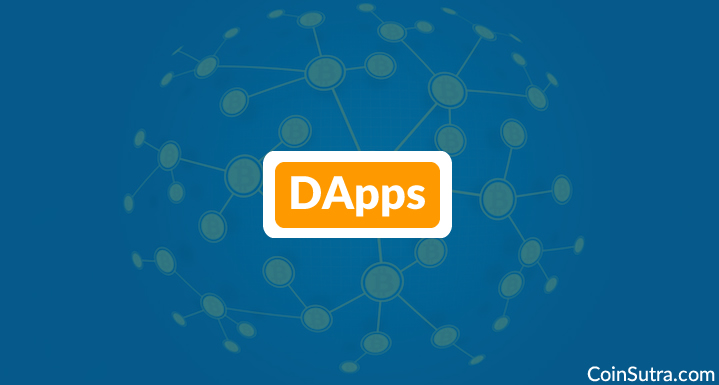What is Dapps ? (Decentralizing the World)
This is a new breed of applications is being discussed across the world. These types of applications are not owned by anyone, can’t be shut down, and cannot have downtime.
Does this sound crazy?
Such new breeds of applications are named DApps (Decentralized Applications).
But before we discuss DApps, let’s talk about the technology underlying DApps, which is called a “blockchain“.
Bitcoin – the first cryptocurrency – introduced blockchain technology to the world. Bitcoin’s blockchain is a globally distributed ledger which records transactions and is secured cryptographically via a robust consensus mechanism.
But digital currency like Bitcoin, which has decentralized all aspects of money, is only one example of a DApp.
Similarly, other DApps built on blockchain technology have opened up the possibility of a newer and more exciting world.
You might be thinking what this new world is all about…
Well, this new world is about making everything as decentralized as Bitcoin’s blockchain did for money.
What are DApps?
DApps is pronounced in the same way that Email is, where the ‘D’ in DApps means decentralized (i.e. D-Apps).
It is difficult to summarize DApps in a 1-2 line definition, as an application needs to have a specific set of characteristics in order to qualify as a DApp.
If an app doesn’t meet all of these criteria, then it is not a DApp:
OPEN SOURCE – Source code of app is available to all.
DECENTRALIZED – Uses a blockchain-like cryptographic technology.
INCENTIVE – App has crypto-tokens/digital assets for fueling itself.
ALGORITHM/PROTOCOL – Generates tokens and has an inbuilt consensus mechanism.
DApps Classification
Based on which blockchain model these DApps use, they are classified into three categories:
Type I
These types of DApps have their own blockchain (like Bitcoin).
Other altcoins also fall under this category as well.
Type II
These types of DApps use the blockchain of Type I DApps.
Type II decentralized applications are protocols and have tokens that are necessary for their function.
The Omni Protocol is an example of Type II decentralized application.
Type III
These types of DApps use the protocol of a Type II DApp.
For example, the SAFE network uses the Omni Protocol for issuing SafeCoins that are then used to build distributed file storage.
Now that you know the different classifications, you might start realizing that many of the crypto-projects that are out now fall under one of these classifications.
And you are absolutely correct to think so!!
DApps Projects
As you probably know, the world’s two biggest blockchain platforms at present are Bitcoin and Ethereum. Several current apps are built on top of these chains.
On the other hand, some apps choose to build their own blockchain.
Here’s a list of some DApps and what “type” they are:
DApps in Action Description
The SAFE Network : A decentralized data storage and communications network Type III SafeCoin (SFE) Bitcoin’s Blockchain
Augur : A fully open-source and decentralized prediction market platform.Type II Augur (REP) Ethereum’s Blockchain
Factom : A decentralized, unalterable record-keeping system.Type I Factom (FCT) Private Blockchain
Golem : A decentralized application to make the first global market for idle computer power Type II Golem (GNT) Ethereum’s Blockchain
Siacoin : A fully open-source and decentralized private cloud Type I Siacoin (SC) Private Blockchain
Storj: A decentralized peer-to-peer protocol to provide the most secure, private, and encrypted cloud storage. A Type II Storjcoin X (SJCX) Ethereum’s Blockchain
Counterparty: A decentralized financial platform for creating peer-to-peer financial applications Type II Counterparty (XCP) Bitcoin’s Blockchain
How Does A DApp Function?
DApps function by implementing all the four criterion which we discussed in the first section. This means that a DApp is an open-source software platform implemented on decentralized blockchains and are fueled using tokens which are generated using a protocol/algorithm.
Being an open-source application makes it truly decentralized as anyone can see and contribute to the code. It also fastens the process for scalability of product development in terms of both quality and quantity.
Decentralizing the app by using a blockchain is the next step. The blockchain serves as a permanent ledger of records/transactions which anyone can refer to at any time.
And finally, to add records/transactions to such ledgers, tokens are used which are mined or pre-mined using different algorithms/protocols.
At present, popular protocols which are used are proof-of-work (which Bitcoin uses) or proof-of-stake (which Dash uses). They are used to reach a consensus or agreement in between all the users of that particular DApp.
Proof-of-work (POW) entails miners to mine blocks and receive rewards. Because mining blocks and adding them to the chain is an energy consumptive process, this also keeps the blockchain secure.
Proof-of-stake (POS) requires holding and staking of tokens in order to become an eligible masternode. This also secures the blockchain and helps in processing transactions.
How To Build A DApp
The process of building decentralized apps is not straightforward as developing any centralized application or software. It has its sequential steps and time frames.
Step 1: Publish a white paper on the DApp with a “road map”.
Publishing a white paper explaining the concept, features, and technicalities of the DApp is important, and is also the very first step. This process will allow feedback to come in from the community, thus making it a true DApp.
If you add the DApp’s “road map”, or plan, it becomes a positive selling point. DApps with solid road maps are ahead of their peers. That’s why it is essential that if you want your DApp to succeed, you must have a solid road map in place in front of the open market.
Also, highlight the capabilities and history of top developers and ideators in your project in order to build trust and reliability among the community.
Step 2: Launch an ICO.
ICOs (initial coin offerings) are the starting points of modern day startups or DApps. In a coin offering, you sell your crypto-coins which will fuel your DApp. These crypto-coins also serve as a way to gather crowdfunding for your project.
Initially, you should announce and explain the aspects of how the ICO of your DApp is going to be. Also, share with the interested community members whether the DApp will be having pre-mined tokens or a mining mechanism in place.
And for building trust, you should highlight how much percentage will go to the development budget, the marketing budget, and other essential allocations. It is important to be transparent with allocations of tokens because most of the DApps projects in the past have ruined their reputation by being not transparent enough.
Step 3: Begin development.
When all is said and done, after procuring the funds and fine-tuning the concept, it’s time to begin development. And once you have begun, it becomes important to share weekly or monthly updates about the development progress to build an inclusive environment for community members.
Step 4: Launch the product.
Launch the product with its detailed release notes and maintenance plans to keep the community involved.
Keep maintaining and modifying it as needed to suit your road map, your vision, and your community.
The Essentials Of DApps
Now that you know how to launch a DApp, you can give it a shot.
But what if you’re not a creative genius with a brilliant DApp idea? How can you still participate?
Well, the answer is you can participate in the ICOs of DApps.
What are DApps’ ICOs and Tokens?
Again, ICO means “initial coin offering”. This is where the DApp’s tokens are sold for the very first time in exchange for other currencies (BTC, LTC, ETH, fiat money, etc.).
DApp tokens are crypto-coins made for the purpose of selling in an ICO to fund the product’s development and also for fueling operations of the DApp.
For example, ETH is the “crypto fuel” for running smart contracts on the Ethereum platform.
These tokens are not pegged to any underlying asset, but they are still valuable because of the unique concept and technology backing them. Moreover, the value of the tokens keep fluctuating based on how much people value the application.
How To Participate In ICOs
If you want to try your hands early on the DApps token, get into an ICO.
Follow the steps below:
Stay Updated – Follow popular crypto and DApps news. Join Slack or Telegram channels of certain ICOs and follow them on Twitter and other social media sites.
Prepare a Wallet – Thoroughly read the ICO details and other technical requirements like which wallet should be used for the ICO. And also check out which currency to buy your tokens in (BTC, ETH, USD, etc.).
Time Factor – Different ICOs list different timings according to different time zones. Check your time zone and be on time. Some ICOs in the past have finished in less than a few minutes, so you have to be really quick and punctual.
But a thing to note is that not all ICOs are worth it. Some ICOs are just scams which only look good on paper.
Analyzing ICOs
So how do you judge whether a DApp’s ICO is a scam or not? Here are a few suggestions:
Check whether the DApp is solving some real life problem.
Check the portfolio and history of the development team.
Check the whitepaper and look at its technical feasibility.
Join forums to check what the technical experts think about the DApp.
Check their development roadmap.
See if they have a working prototype demo of the DApp.
These are only a few of the preconditions; we suggest you do your research and due diligence before getting into any ICO for a DApp.
Future of DApps
What we are experiencing now is like a sneak peak to a decentralized world which is about to come in full swing.
Even David Johnston, CEO of the DApp Fund, predicts this in his white paper:
“These decentralized applications will some day surpass the world’s largest software corporations in utility, user-base, and network valuation due to their superior incentivization structure, flexibility, transparency, resiliency, and distributed nature.”


Besides a few strong cryptocurrencies, the truly innovative dAapps will have the future.
Solid post. Good to see I'm not the only one that is thinking about this. Only invest in ICOs if you did the best possible research you can do and really believe in the future of the project. Wetter you're a short- or long term holder you should know what you put your money in. I found this great website: https://www.coincheckup.com For a complete crypto analysis on every single tradable crypto out there.
Great post @hamzat!
This is was a good overview of Dapps, much appreaciated.